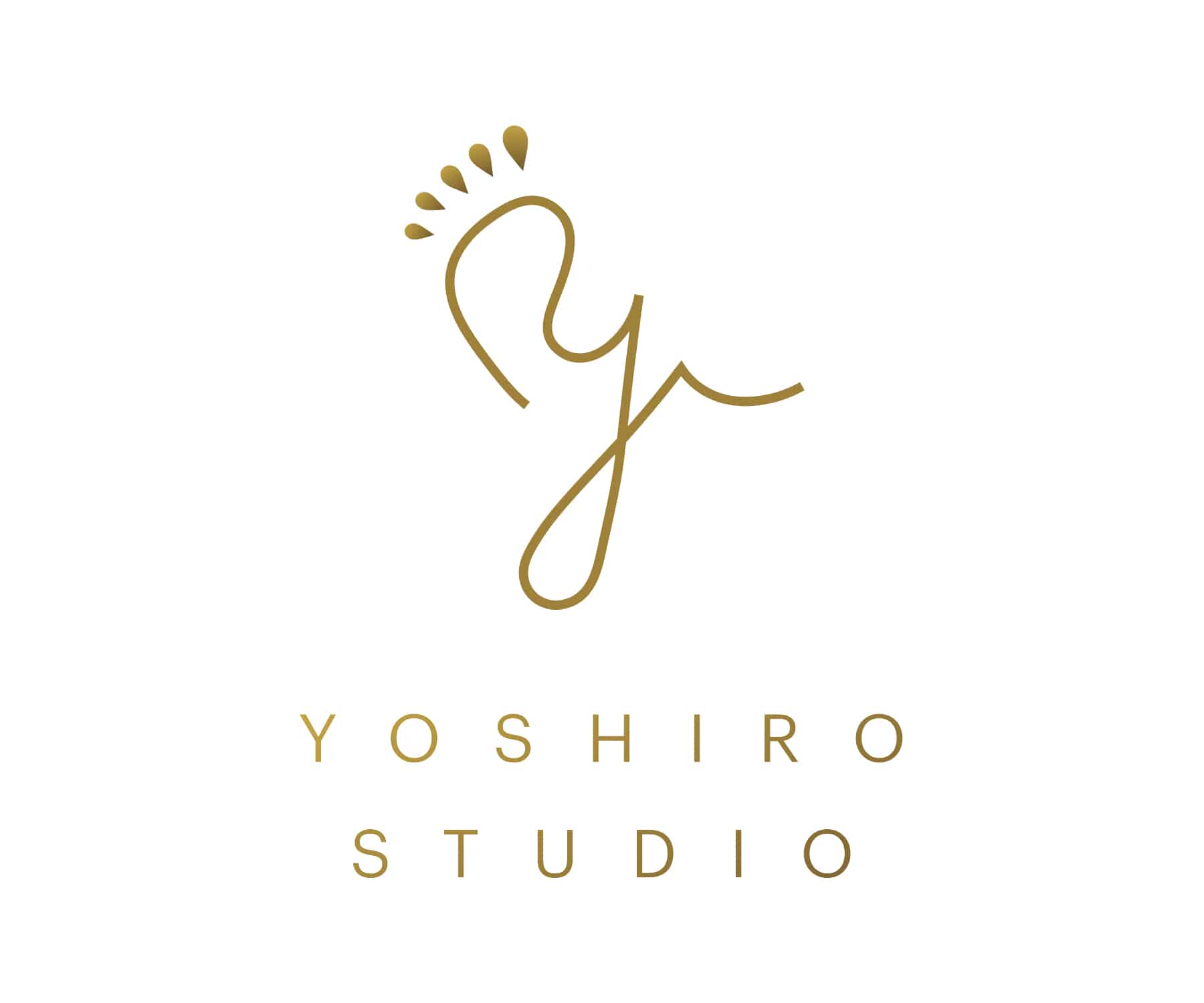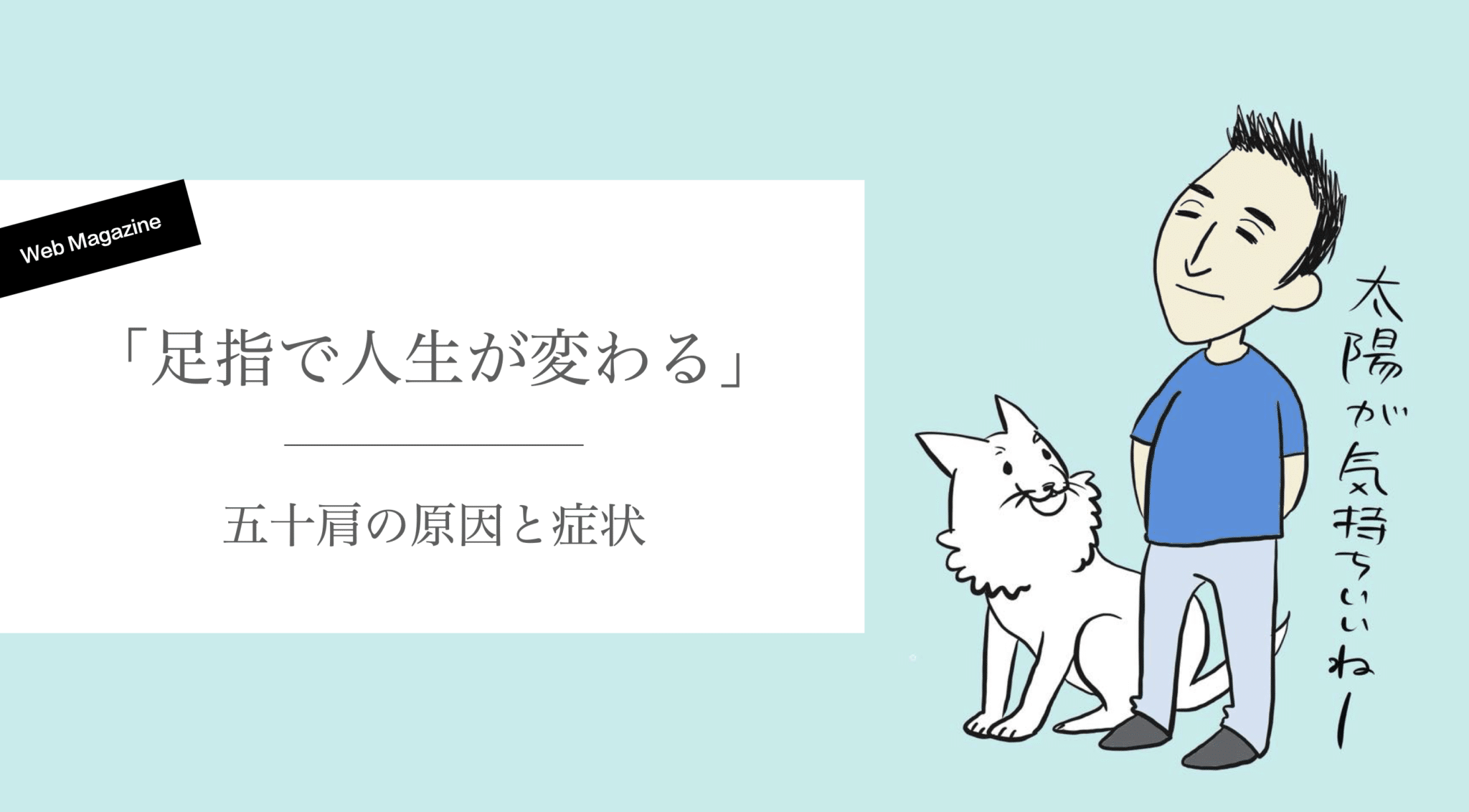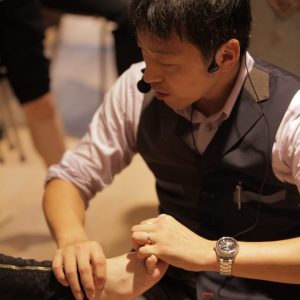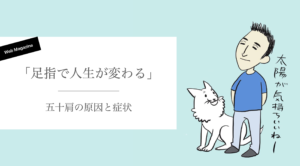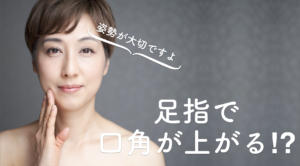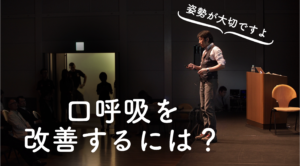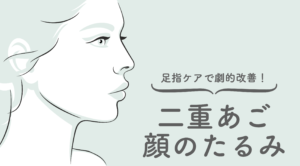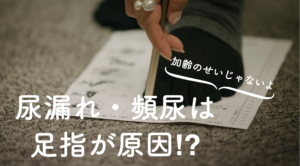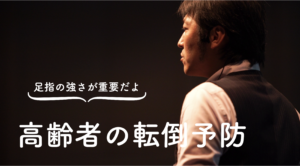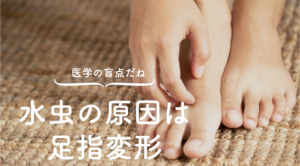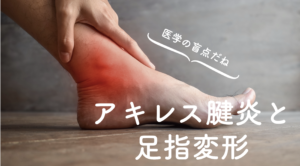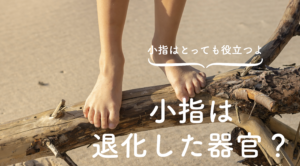Commentary by a toe doctor

YOSHIRO YUASA
Keiro Yuasa
Dr. Toe, Director of Toe Research Institute, President of Japanese Society of Functional Foot and Toe Therapy, and developer of Halmek shoes. Former director, vice president, and medical director of General Hospital. He specializes in exercise physiology and anatomy. He is also a foot and shoe specialist and a leading expert in postural occlusion therapy. He has cured various orthopedic diseases (over 70,000 people) with toe therapy alone.
Introduction.
Hunchback is a condition in which the spine and shoulder blades project forward and the posture is rounded. If the hunchback posture continues, the shoulder and neck muscles become easily strained, and this can cause frozen shoulder. Therefore, correcting posture and properly stretching and training shoulder and back muscles can help improve and prevent frozen shoulder and hunchback.
summary
Fifty shoulder is a type of periarthritis of the shoulder joint, a condition generally seen in middle-aged and older people over 50 years of age.It is. It is a condition in which the soft tissues (ligaments, tendons, etc.) surrounding the shoulder joint become inflamed, causing pain and limitation of movement. It is usually characterized by sudden, severe pain and restricted shoulder motion. Treatment generally includes medication to reduce inflammation and physical therapy (massage, stretching, etc.). However, surgery may be necessary if symptoms are chronic.
normal
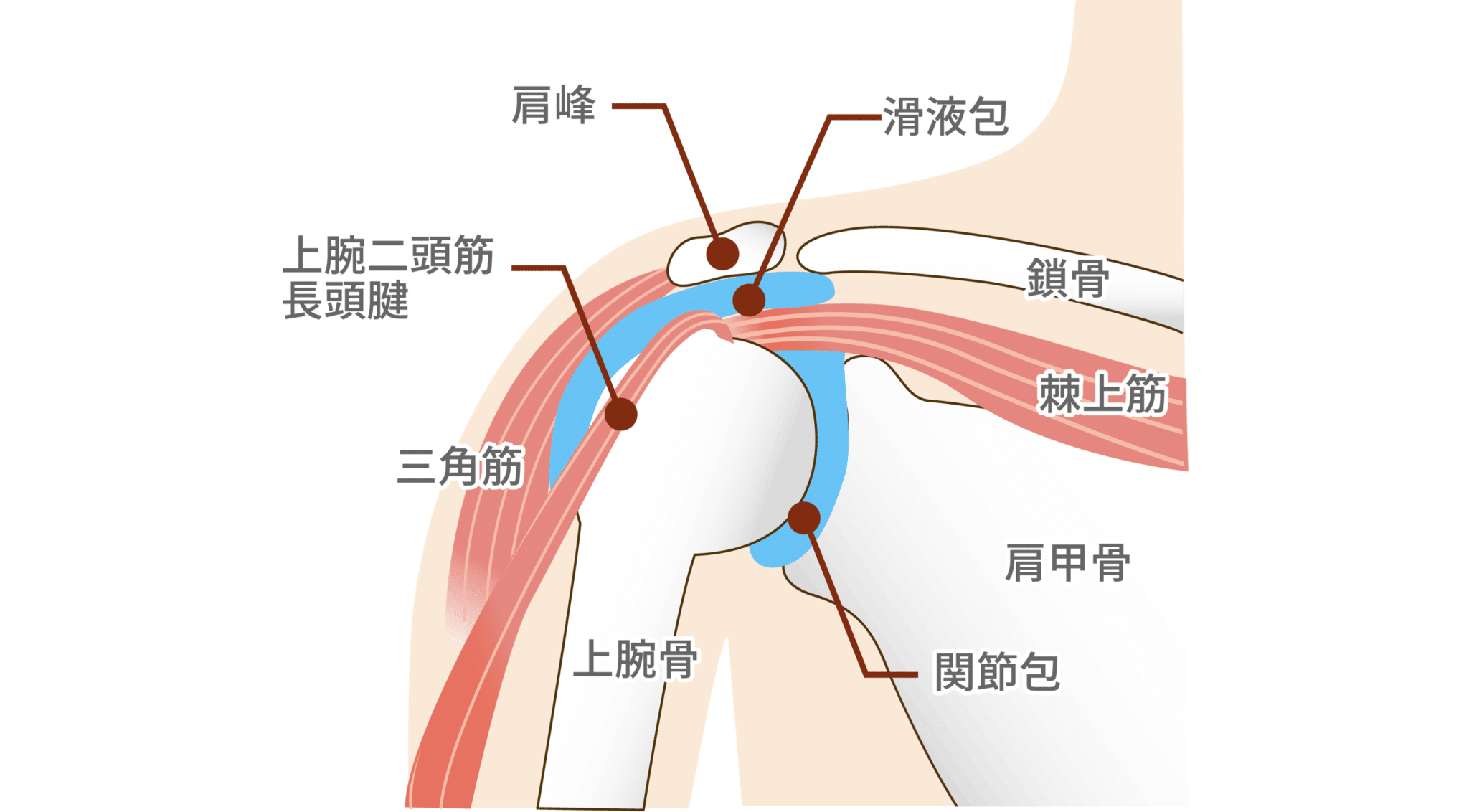
frozen shoulder
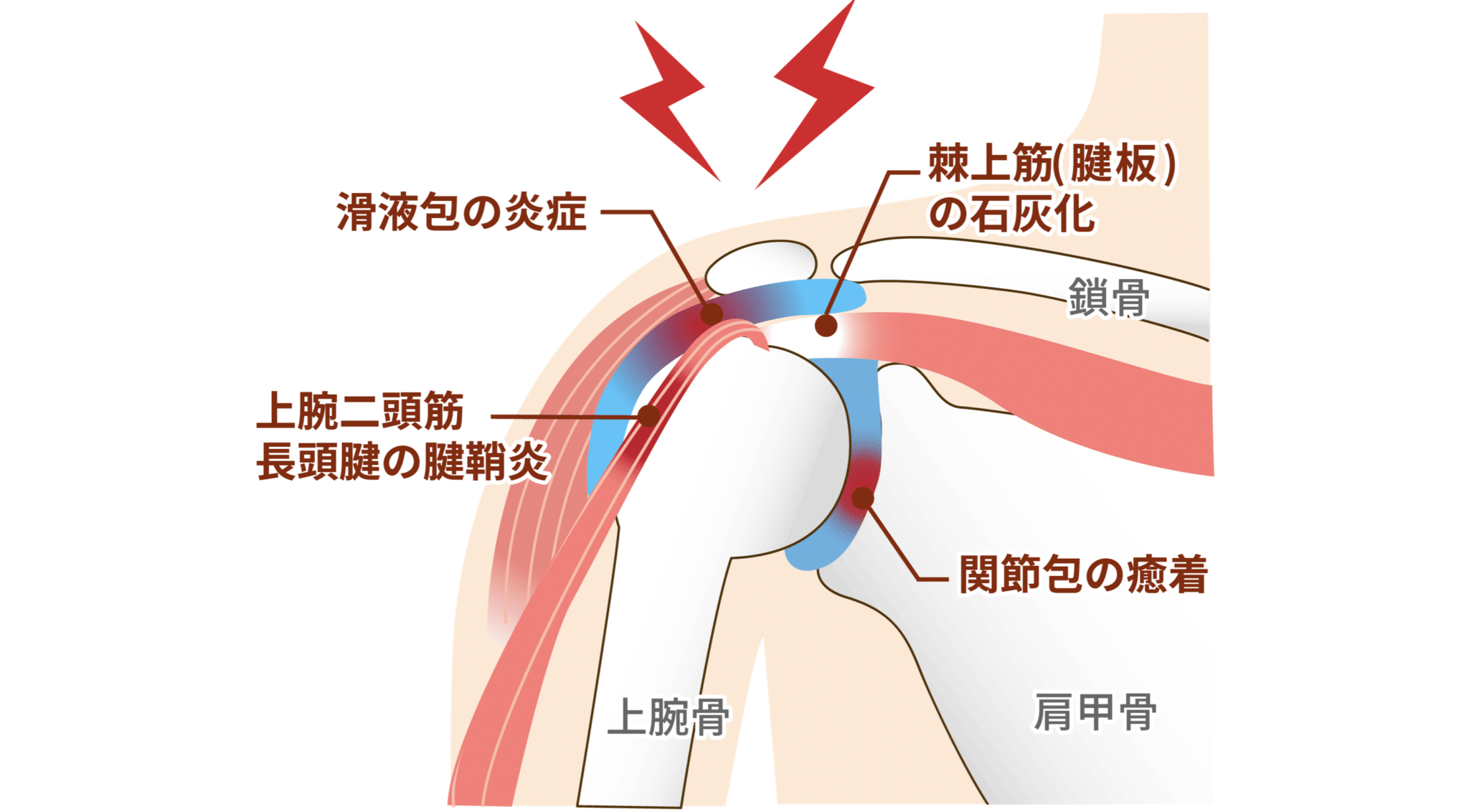
Fifty shoulder is one of the symptoms of restricted range of motion of the shoulder, which is closely related to postureIt is believed that Prolonged poor posture can cause excessive tension in the muscles and ligaments surrounding the shoulder, resulting in poor circulation, which can lead to frozen shoulder. In particular, prolonged stooping or one-sided bearing posture can strain the shoulder muscles and increase the risk of frozen shoulder. In addition, poor posture can prevent proper movement and cause a limited range of motion in the shoulder, which can lead to frozen shoulder. Therefore,It is important to correct the toes in order to maintain correct postureIt is.
symptoms
Symptoms of shoulder pain and limited range of motion in the shoulder (periarthritis)but these symptoms are common in many shoulder diseases. An important symptom of adhesive arthritis is severe stiffness that makes simple movement of the arm almost impossible. The pain caused by forty or fifty shoulder (periarthritis) is usually dull or tingling and may be worse at night or with any movement. It is important to begin appropriate treatment as soon as possible if any of the following symptoms appear
- Sudden strong shoulder pain
- Restricted shoulder range of motion
- Difficulty moving the shoulders and feeling of stiffness
- Pain or discomfort around the shoulder joint
- Sometimes painful arm movements.
- Pain may persist at night or during rest if it worsens
Causes and pathogenesis
arisorrhea
There are multiple factors that contribute to the development of frozen shoulder, but in general, the main ones in medicine are as follows
- Aging: As we age, the flexibility of our joints and muscles decreases, limiting shoulder motion, which can lead to frozen shoulder.
- Excessive use or rapid exercise: Excessive stress or rapid exercise on the shoulder joint and surrounding tissues can cause inflammation and damage.
- Excessive use of the shoulder or poor posture: Using the shoulder in the same position for long periods of time or maintaining an improper posture can strain the shoulder joint and cause frozen shoulder.
- Lack of exercise: Lack of exercise and muscle weakness can lead to weakness of the muscles around the shoulder joint, which can restrict shoulder motion, resulting in the development of frozen shoulder.
- Stress and emotional strain: Stress and emotional strain on the shoulder can increase muscle tension and cause inflammation around the shoulder joint.
- Immune reactions and diseases: immune reactions such as rheumatoid arthritis and diseases such as diabetes can cause frozen shoulder.
A combination of these factors can cause frozen shoulder. If symptoms of frozen shoulder persist, early treatment is important. Basically, in medicineThe detailed mechanism of frozen shoulder is not yet understood.Therefore, hospital treatment and rehabilitation are not expected to improve symptoms.
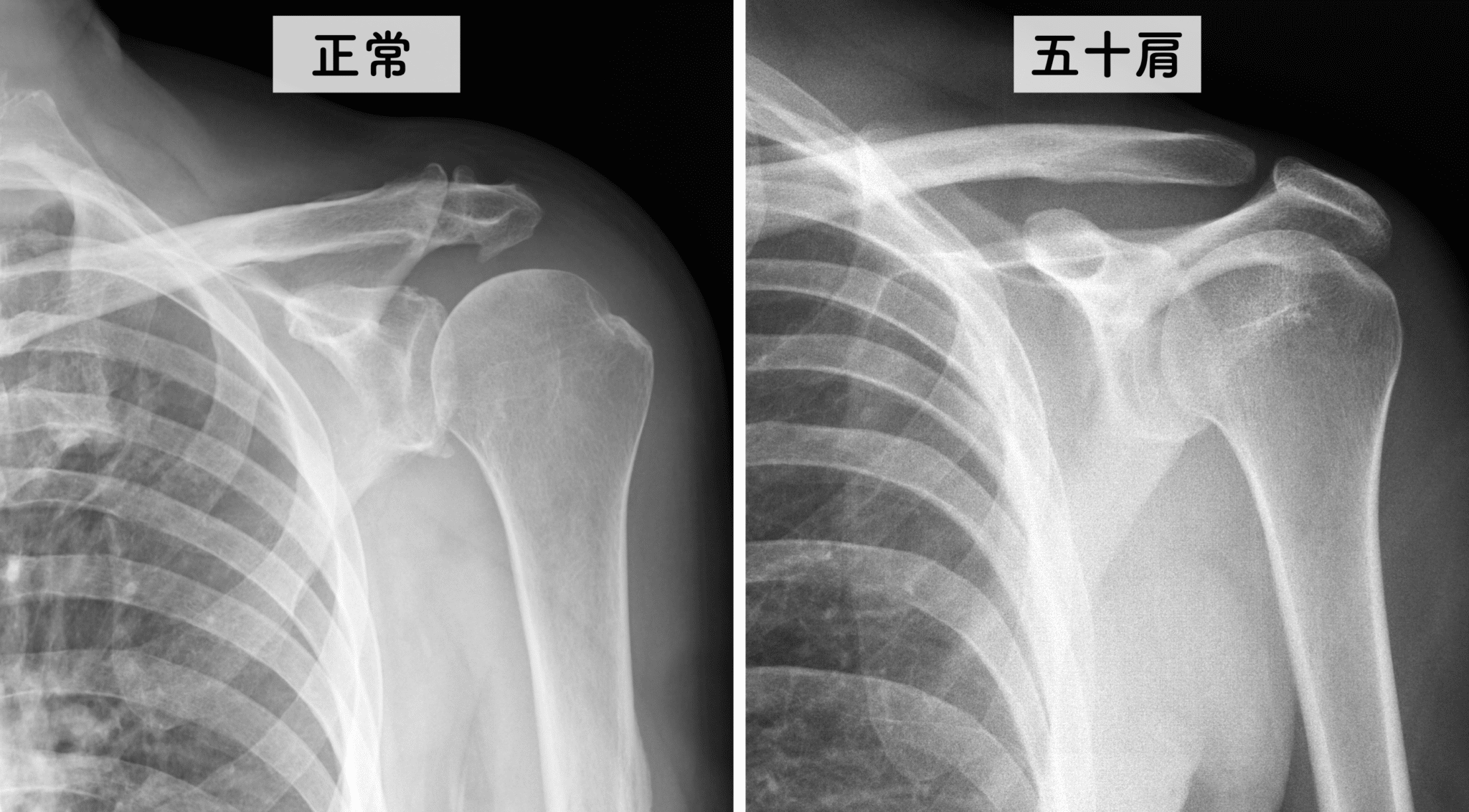
Take a look at the picture above.Most people with a frozen shoulder have a fisted bony head.. As a result, the gap between the humeral head (arm bone) and the acromion (second shoulder joint) narrows, and inevitably the supraspinatus muscle is caught in between, making it more prone to rotator cuff tears, subacromial bursitis, long head biceps tendonitis, calcific tendonitis and rotator cuff tears. Looking only at the bad parts, the problem is in the shoulder, but it is the "posture" that causes the shoulder to elevate.
Mechanism (1)
A simple explanation,(1) Type of shoes and how to wear them → (2) Toe deformity (Hallux valgus, Hallux valgus, floating toe) → (3) Lateral center of gravity → (4) O-leg/X-leg → (5) Leg length difference → (6) Pelvic distortion → (7) Spine distortion → (8) Shoulder elevation → (9) Shoulder joint periarthritis → (10) Fifty percent shoulderThis is the mechanism that
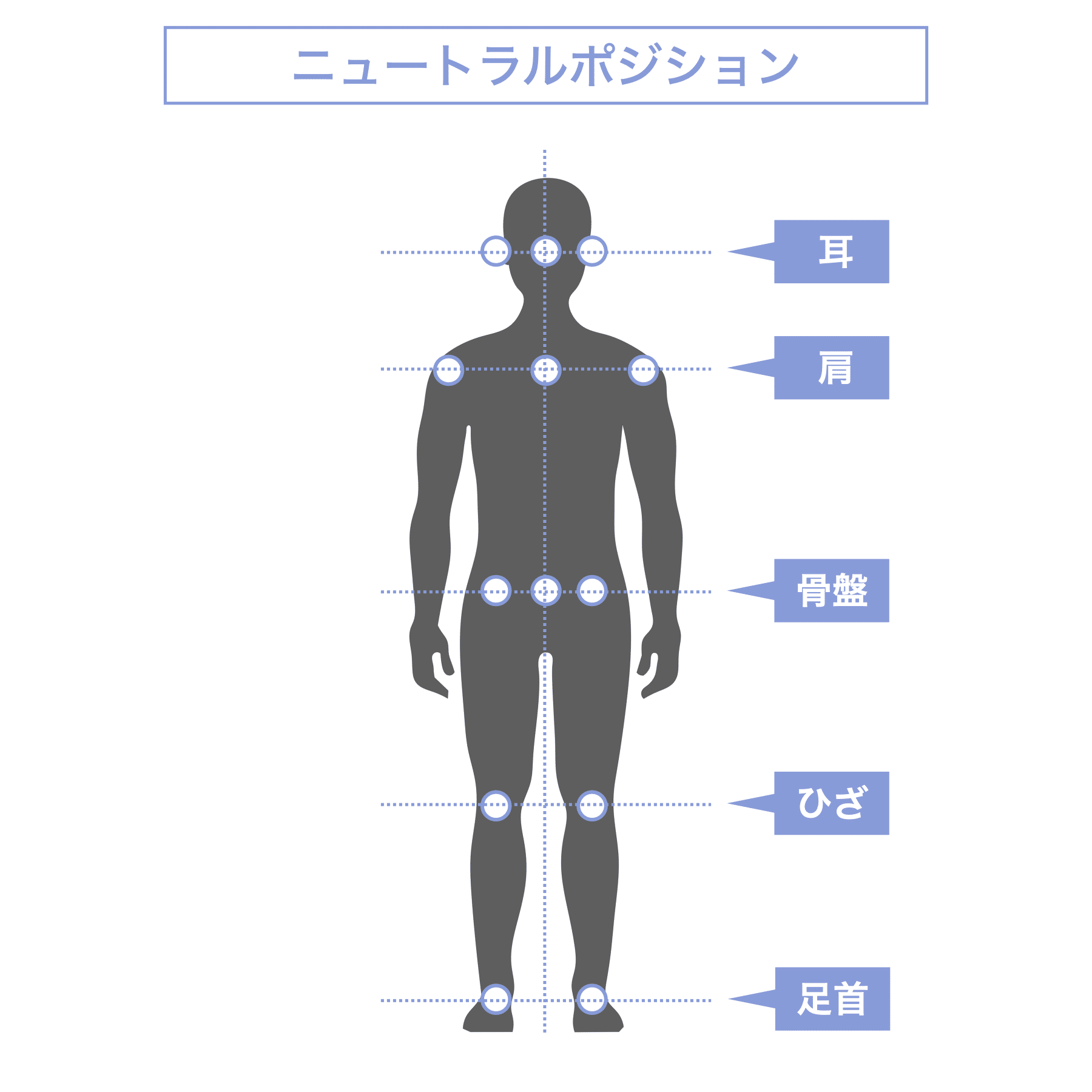
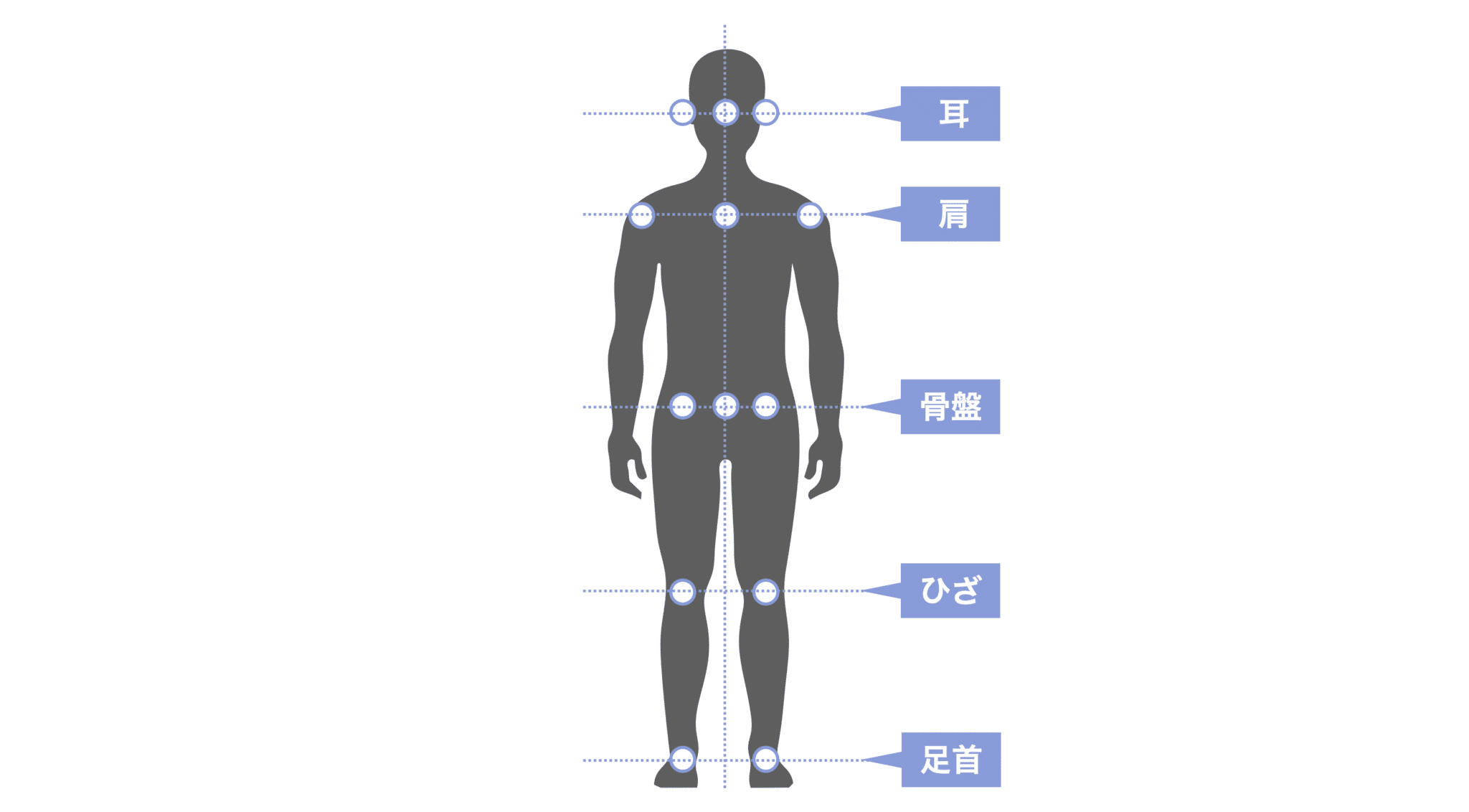
Essentially, if the toes are extended, the length of the legs will be symmetrical, the position of the pelvis will be symmetrical, the spine will not be distorted, and the height of the shoulders will be the same on both sides.
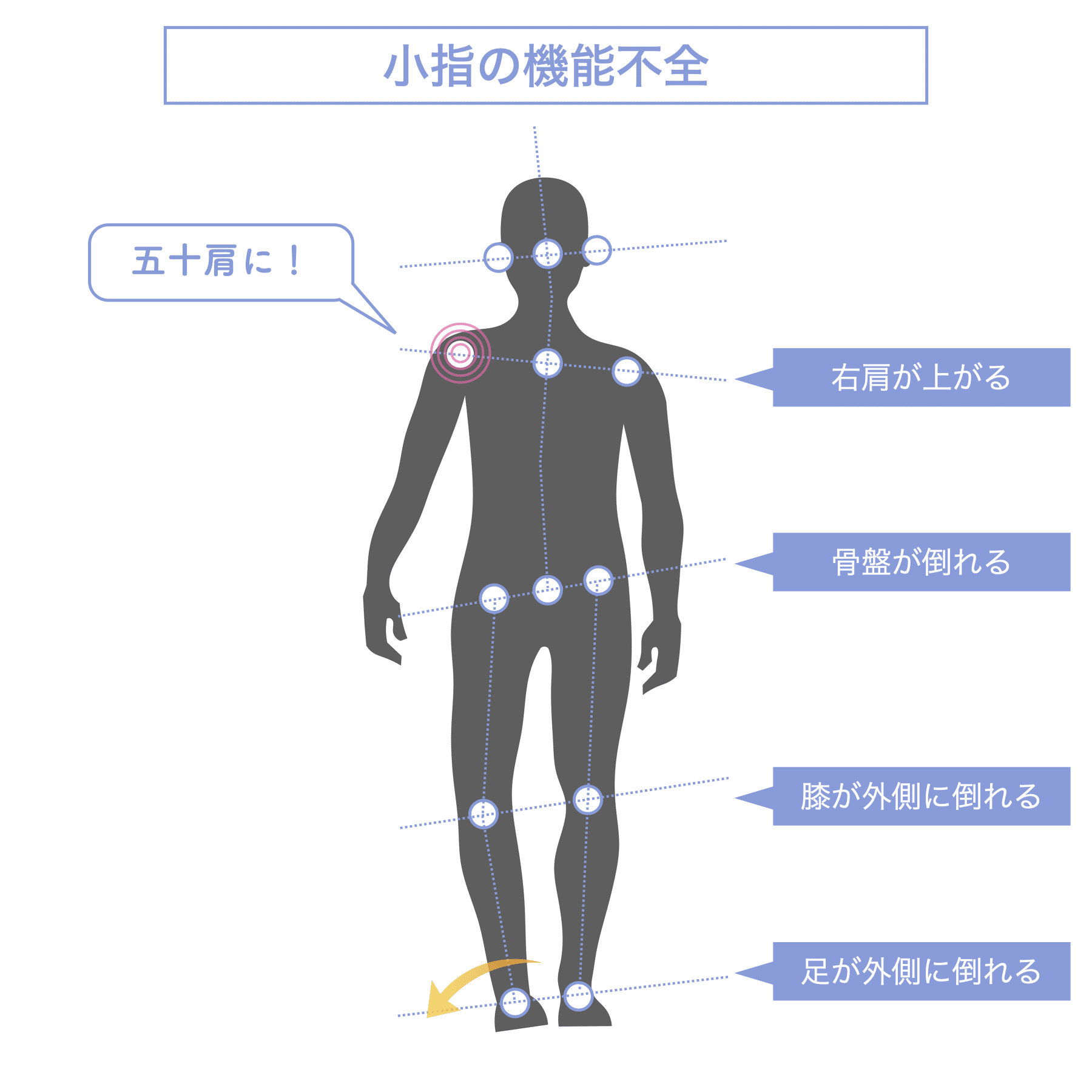
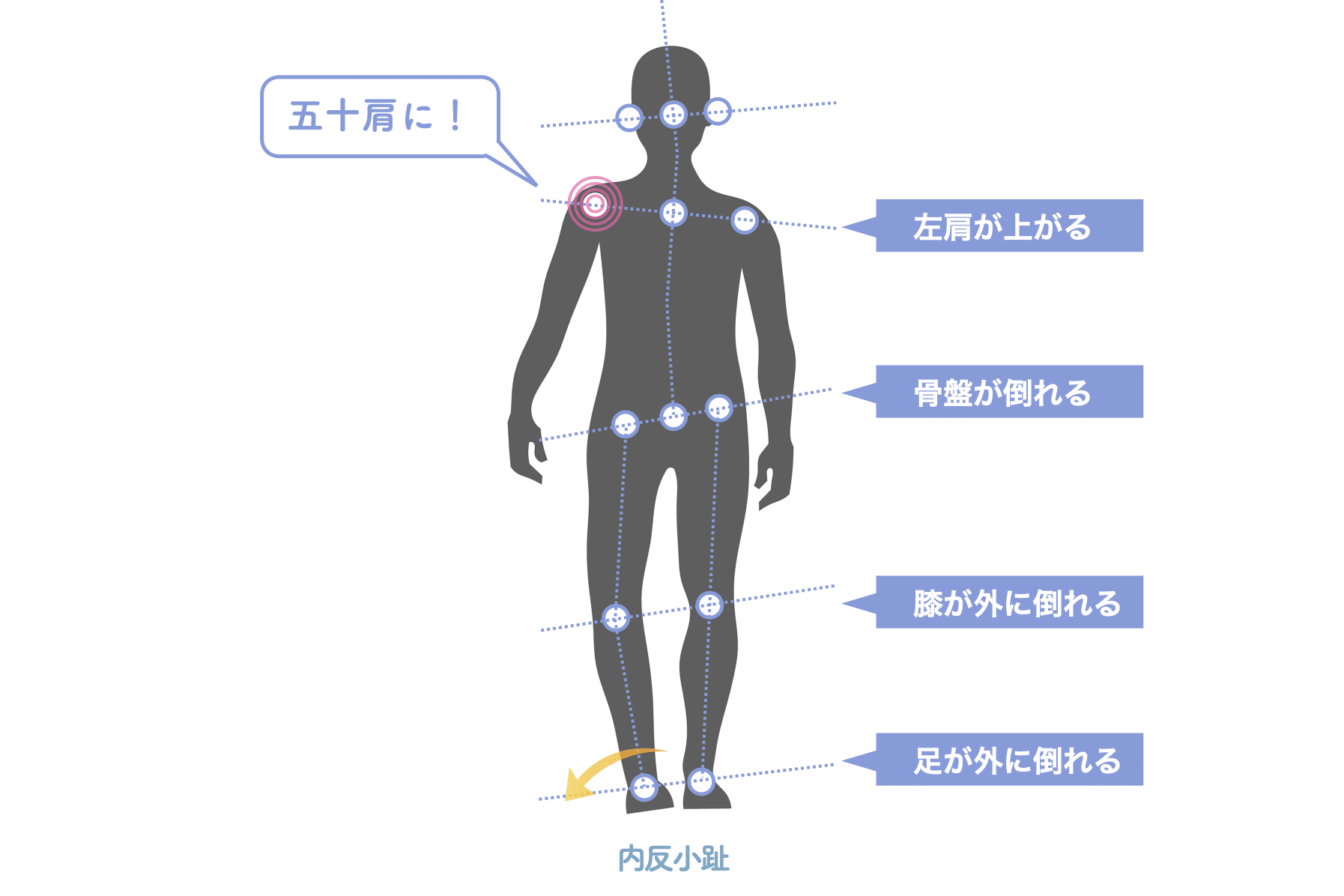
However,When the big toe or little toe is dysfunctional, the foot falls to the outside.The little toe acts as a stopper to prevent the foot from falling outward, and the knee will also fall outward. If both legs fall outward symmetrically, there is no problem, but since people have "dominant" and "compensatory" legs, one of them will fall "more outward" than the other.
When it comes to that,The pelvis on top of both legs collapses toward the "short leg"This is the cause of pelvic distortion. When the pelvis collapses, the spine on top of the pelvis collapses along the pelvis, but tries to balance itself by bending in an S-shape. This is also called scoliosis.
As the spine bends, the shoulders in turn fall to try to balanceThe right pelvis is "right shoulder up" and the left pelvis is "left shoulder down". When the right pelvis is lowered, the "right shoulder rises" and when the left pelvis is lowered, the "left shoulder rises". This is due to postural control, a natural law, which is a way to maintain an upright posture by generating appropriate motor output. An elevated shoulder can cause inflammation around the shoulder joint and narrowing of the shoulder joint, which limits the range of motion of the shoulder and makes it more likely to develop a frozen shoulder.
Mechanism (2)
Another mechanism is,(1) Type and way of wearing shoes → (2) Toe deformity (clawed toe, floating toe) → (3) Backward center of gravity → (4) Hunchback/warped back → (5) Curved shoulders/ankle shoulders → (6) Shoulder joint stricture/stenosisInflammation around the shoulder joint→7) frozen shoulderThis is the mechanism that
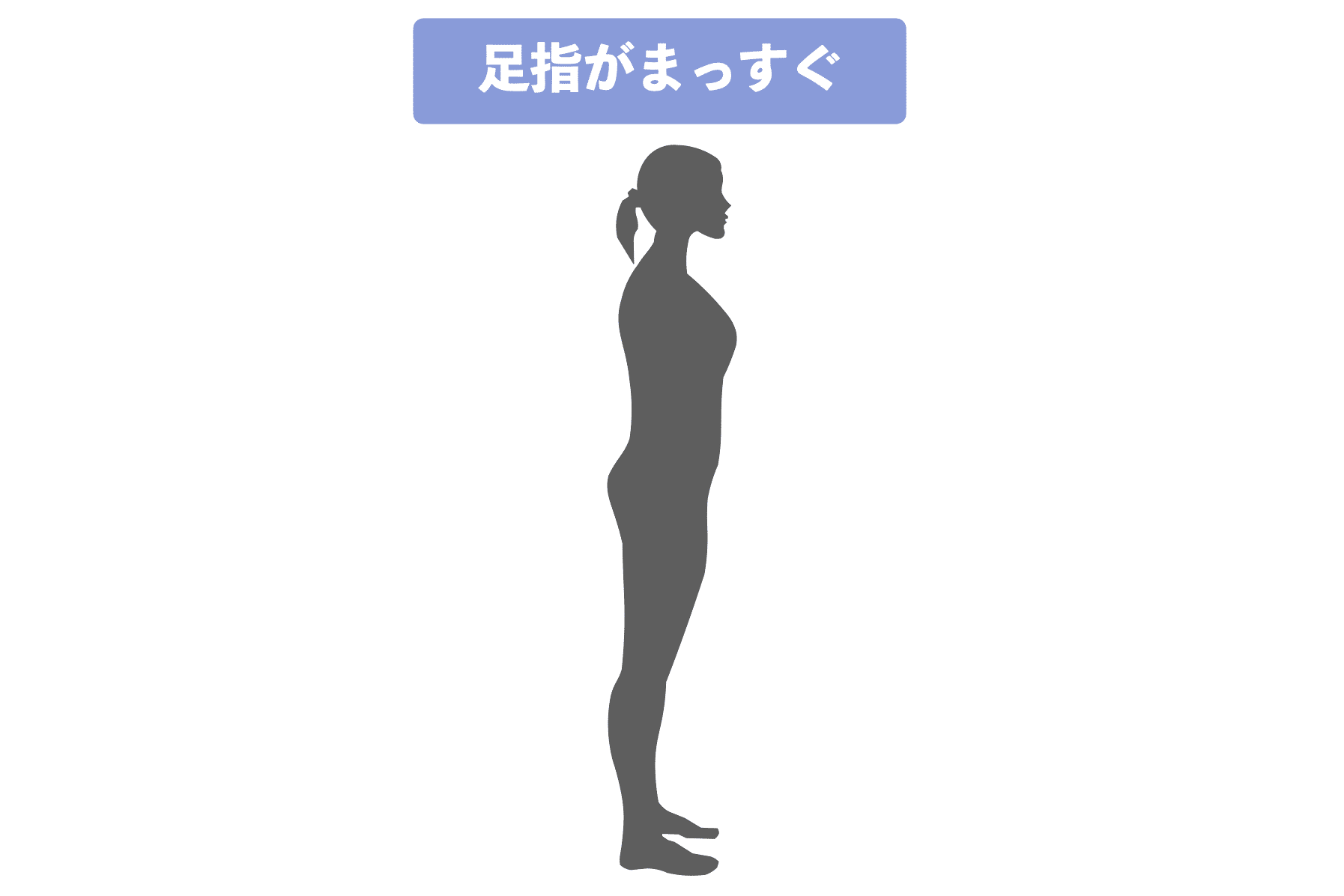
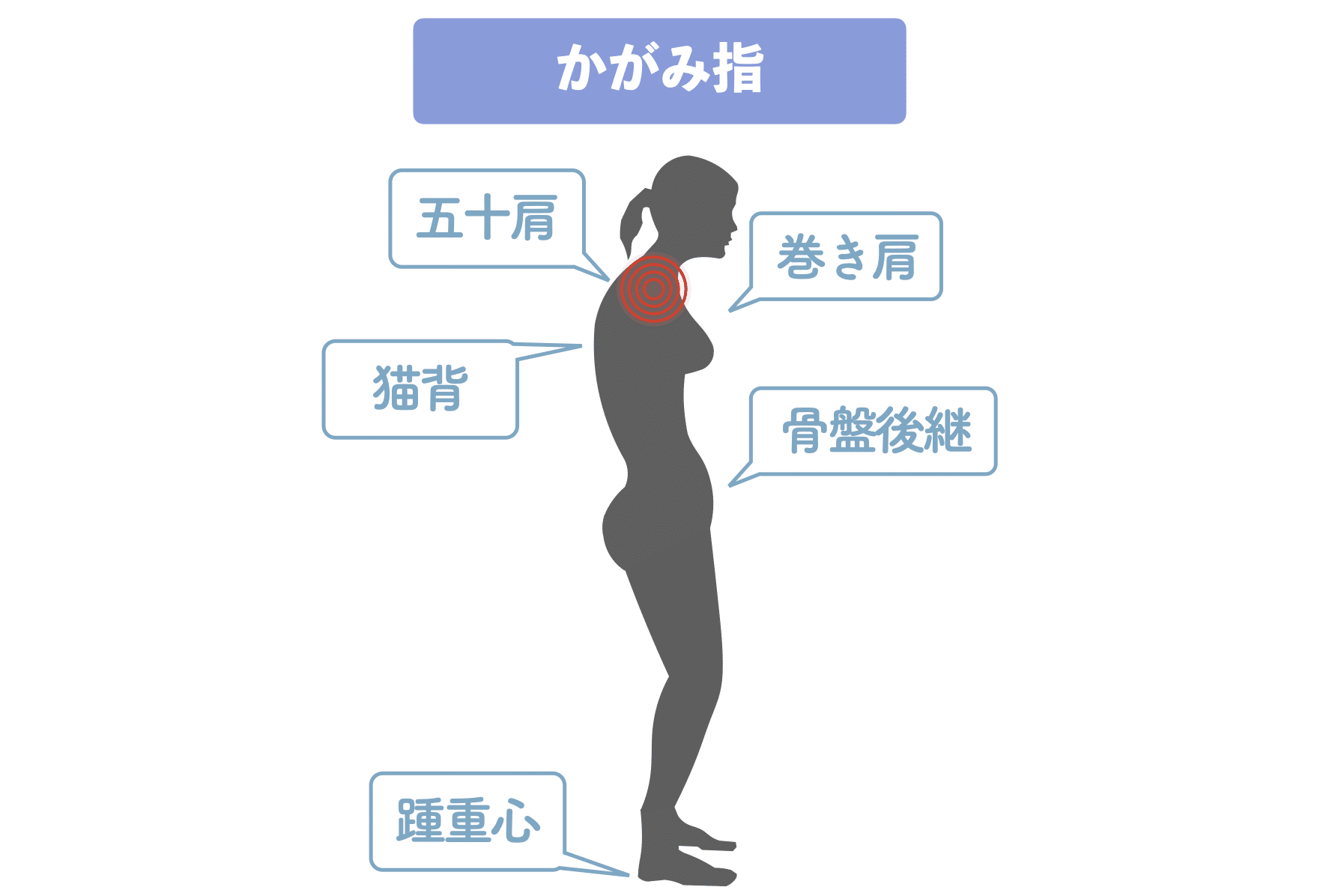
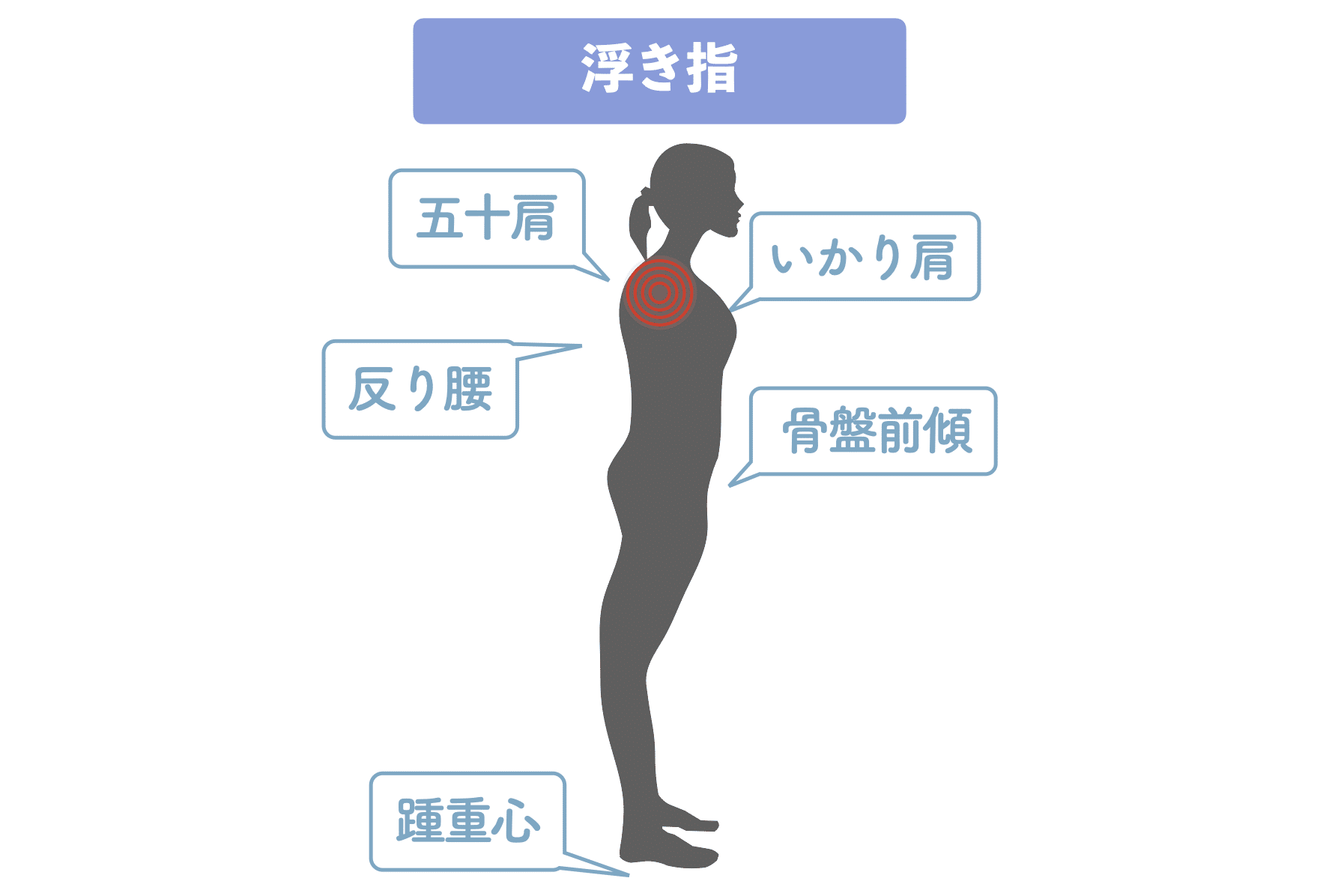
When the toes are bent or floating, the body weight is placed closer to the heel (heel center of gravity). The heel center of gravity causes the posture to fall backward, but the body tries to maintain balance by tilting the trunk forward or backward. This is also called postural control. If we do this, we will hunch over or warp back,If you have a hunched back, you have rolled shoulders.."Left and right shoulders tucked inward anteriorly.The "M" will be "M".In the case of a warped back, the shoulders are always raised.The "M" will be "M".
In the case of a "rolled shoulder" or "ankle shoulder," the upper arm bone moves back and forth, causing narrowing of the joint and limitation of range of motion.These distorted postures over a long period of time can cause excessive tension in the muscles and ligaments around the shoulder, resulting in poor blood circulation and frozen shoulder.There are times when
Both of these are caused by postural changes due to toe deformities,Unless you treat the "toes" that make up your posture and the shape of your legs, you will have nothing to treat your frozen shoulder!You will find that
Deformity of the toes and its causes
Most people today have deformed toes due to the wrong choice of shoes and socks, and the way they wear them.and the foundation is collapsing. Please refer to the following website for more information.
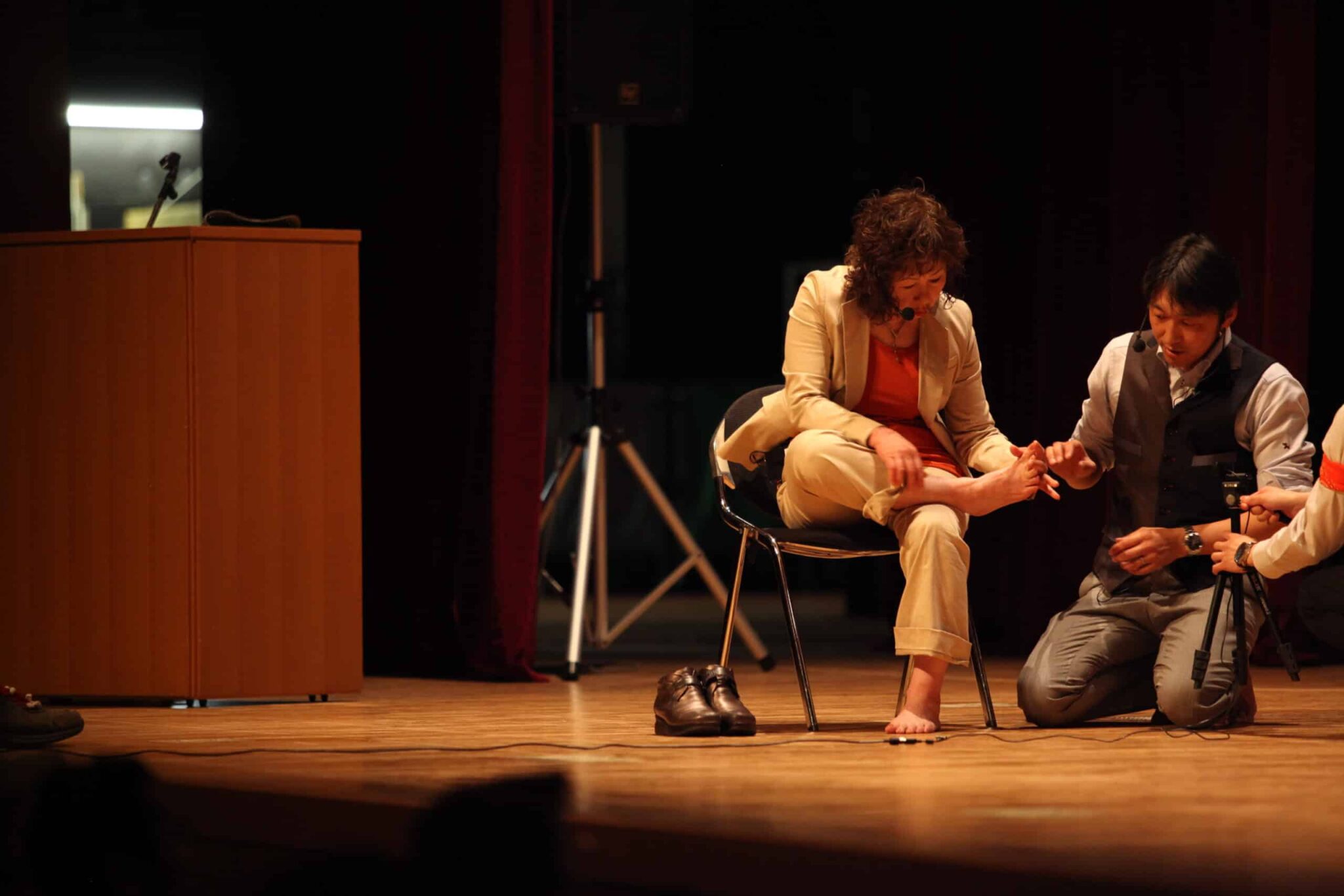
Inspection (Self-Check)
Fifty shoulder (periarthritis) is a condition that limits the range of motion of the shoulder. Below is a method for self-checking for frozen shoulder.
- Move the shoulder back and forth: Check for pain or discomfort when moving the shoulder back and forth or side to side. In particular, pain is often felt when moving the shoulder backward.
- Move the shoulder up and down: check for pain or discomfort when moving the shoulder up and down. In particular, pain is often felt with the movement of raising the shoulder.
- Move the shoulder in a circular motion: check for pain or discomfort when moving the shoulder in a circular motion. In some cases, the circular motion may cause pain.
If you experience pain or discomfort with any of the above movements, it is possible that you have a frozen shoulder, and we recommend that you correct your toes and improve your posture. Early improvement can be achieved by correct shoe selection and shoe wear.
Self-check of posture (1)
First, take a picture of your posture from right beside yourself with your phone or other device. Take the picture so that the center point of the phone is at the center of your body. It is a good idea to make sure that the leveler is positioned at your navel.
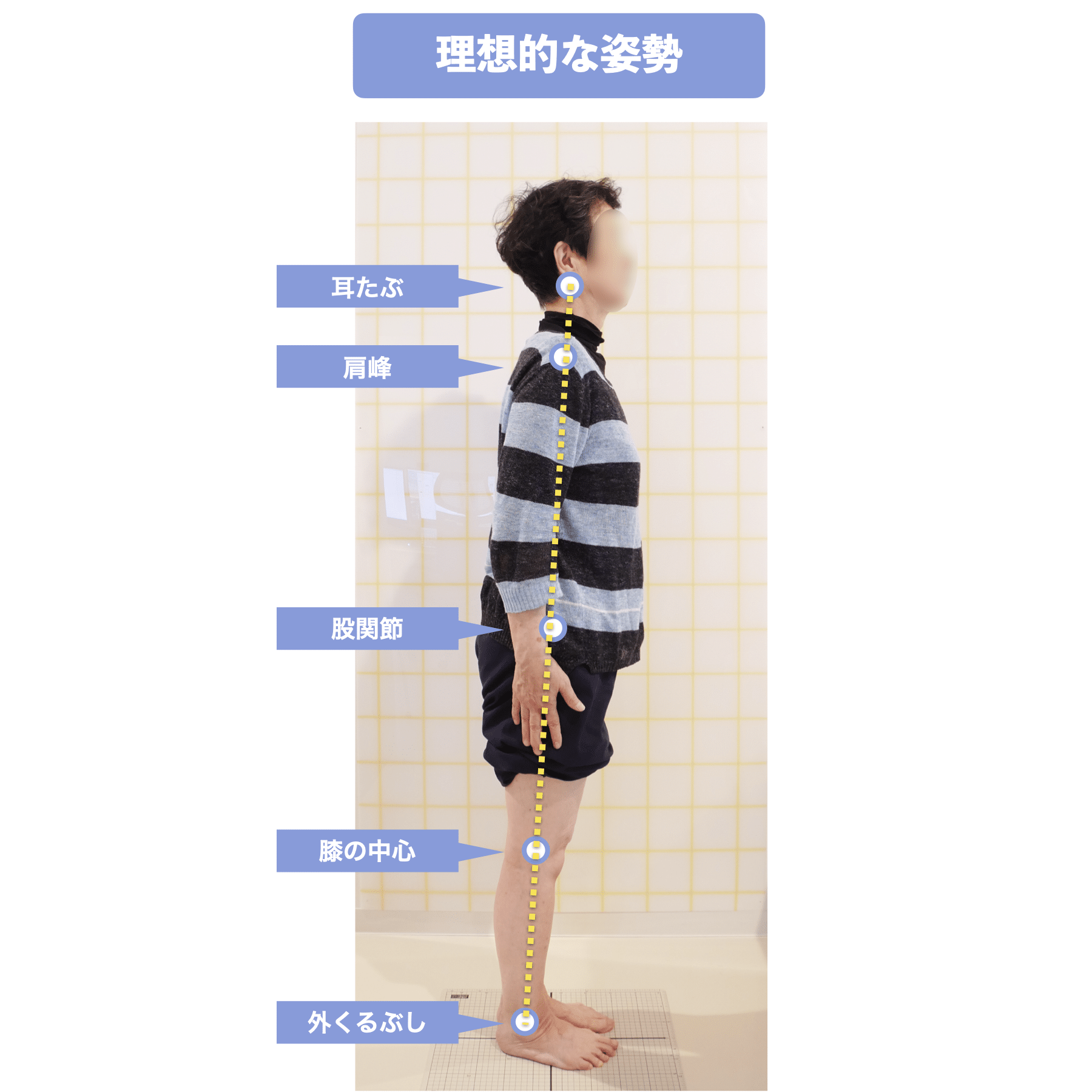
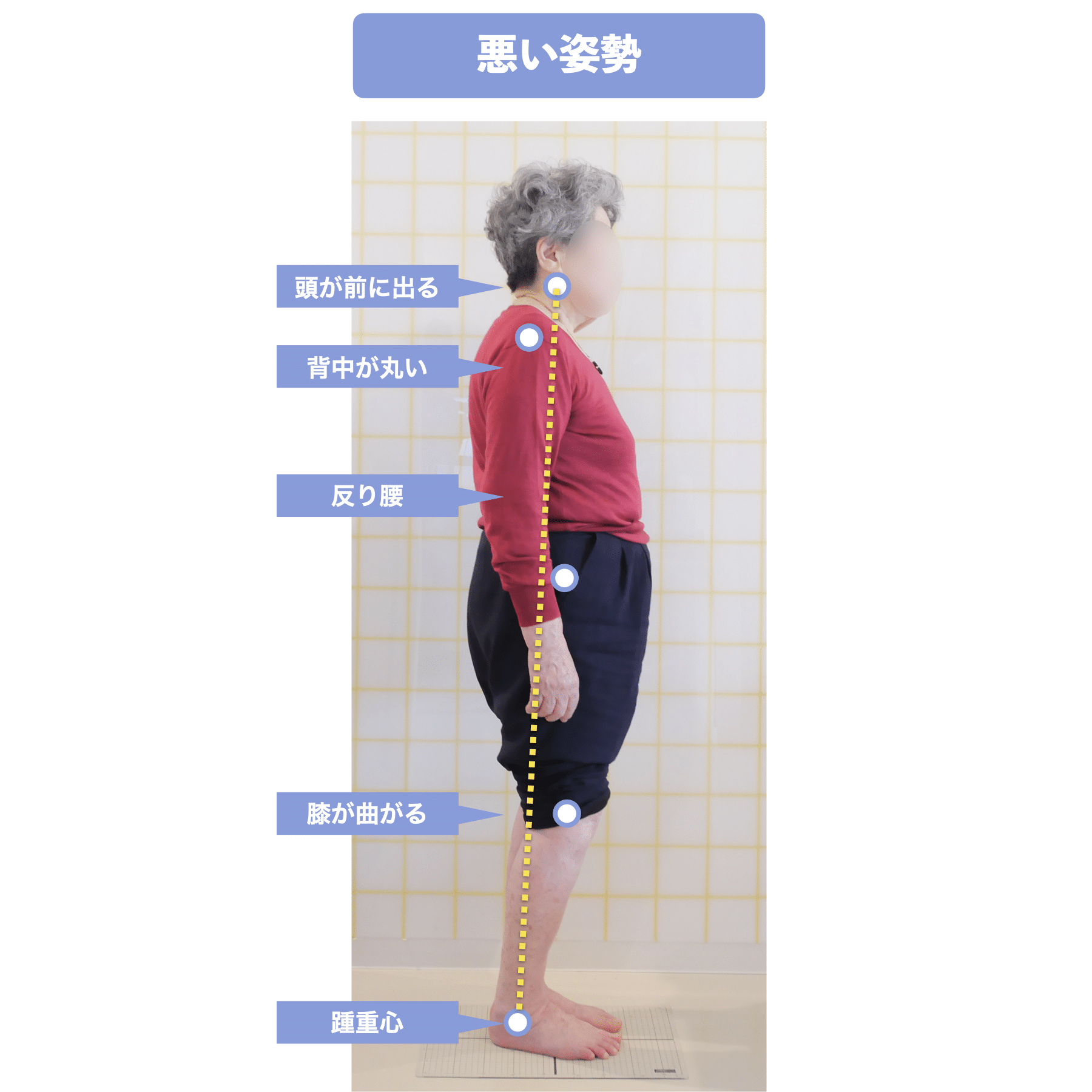
Next, connect the earlobes (earlobes) to the external ankles (outer ankles) of the feet with a line.The ideal posture is if (1) the center of the knee, (2) the greater trochanter (hip joint), and (3) the acromion (center of the shoulder) pass through that straight line.If you have trouble drawing a line, use a ruler to align the earlobe with the outer ankle. If you are not comfortable with drawing lines, use a ruler or similar tool to align the earlobes with the outer ankles.
If any of (1), (2), or (3) is out of alignment with the straight line, you are standing with your neck forward in a hunchback or warped back (except for some with a warped back). How did you feel? I think most of you had a hunchback or warped back.
Self-check of posture (2)
Now take a picture of the posture from the front with your smartphone or other device. You can also check your posture while looking in the mirror.
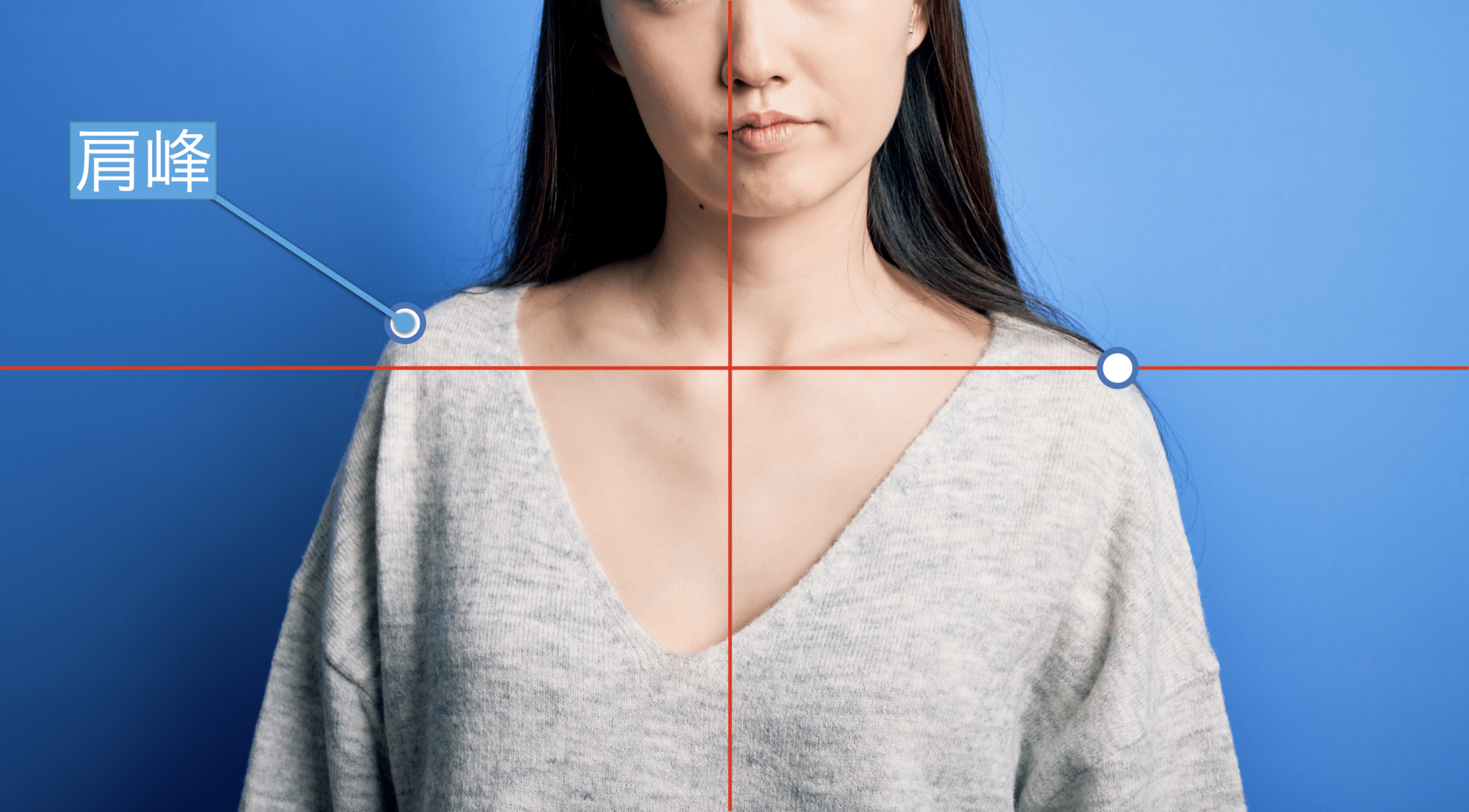
Align the horizontal line with your shoulders. Were both shoulders at the same height?If both shoulders are at the same height, there is no body distortion. In most cases, either the right or left shoulder is elevated. If the right shoulder is elevated, there must be some problem with the right toe, and if the left shoulder is elevated, there must be some problem with the left toe.
medical treatment
The frozen shoulder is one of the symptoms caused by periarthritis or rotator cuff injuries, and treatment generally involves the following
- conservative treatment
- Use of NSAIDs (nonsteroidal anti-inflammatory drugs) and pain-reducing agents
- Rehabilitation programs such as physical therapy, massage, stretching, etc.
- Moderate physical activity such as swimming and light exercise
- injection therapy
- Sedation of inflammation by steroid injection or intra-articular injection
- Regenerative medicine with platelet rich plasma (PRP) therapy and hyaluronic acid injections
- procedure
- Surgical treatment may be the treatment of choice if conservative or injection therapy is ineffective
- Rotator cuff repair surgery and arthroscopic surgery are performed.
Although there are various medicines on the market to alleviate the pain of frozen shoulder, such as drinking pills, poultices, and ointments, it is important to approach the "toes" and correct the posture in order to improve frozen shoulder. Hospital treatment, rehabilitation, massage, myofascial release, etc. may temporarily relieve pain, but they do not provide a fundamental solution.
drug
Drugs such as NSAIDs can be used for pain control. Oral steroids may have short-term effects on range of motion and pain, but have side effects such as hyperglycemia. Corticosteroids may also be used by local injection. In the short and medium term, intra-articular corticosteroid injections may be most effective in reducing pain and increasing range of motion, but injections are associated with complications. Unfortunately, the effects of the drugs do not last long. Especially oral corticosteroids,Should not be used continuously for the treatment of adhesive arthritis due to the risks associated with long-term useThe following is a list of the most common problems with the
Exercise and Physical Therapy
Shoulder stretching and strengthening exercises can improve shoulder function and reduce pain, though,No significant effect as evidence... Extracorporeal shock wave therapy (ESWT) is the recommended method of reducing pain and improving range of motion and function in stage 2 and 3 frozen shoulder. Laser therapy can be equally effective for stage 2 frozen shoulder; interventions such as PNF techniques (stretching), other motor exercises, dynamic scapular stabilization exercises, and conventional physical therapy may improve pain but do not eliminate the underlying frozen shoulder.
procedure
If conservative measures do not work, surgery can be tried. In long-term severe cases, surgery to sever the adhesions (capsulotomy) may be performed. This surgery is performed by arthroscopy. The underlying cause of the limited range of motion of the shoulder can be found and corrected. However, if the posture is compromised, there is a high likelihood of recurrence,After the surgery, it is recommended to take care of your toes to correct your postureThe following is a list of the most common problems with the
prognosis
Most cases of frozen shoulder (adhesive arthritis) heal spontaneously, although it may take one to three years to resolve completely,Pain and stiffness do not completely resolve in people with 20-501 TP3TIt has been reported that It is important to properly care for the toes and improve posture rather than waiting for them to heal naturally.
self-care
Self-care for frozen shoulder generally includes the following
- Use coolants or warm compresses to reduce pain.
- Stretching and massaging to relax the muscles around the shoulders
- Perform exercises to increase the range of motion of the shoulder joint
- Improve posture and movement to reduce shoulder strain in daily life
- Improve sleep quality with appropriate pillows and bedding
- Avoid straining postures and movements
- Incorporate relaxation techniques to reduce stress
Continued use of these self-care methods can relieve the symptoms of frozen shoulder. However,Not very effective if symptoms are severe or if pain or inconvenience persistsThe following is a list of the most common problems with the
To eliminate contractures and adhesions of muscles and ligaments around the shoulder due to muscle fatigue and poor circulation, it is effective to correct your feet and regain the correct posture that human beings are supposed to have. try to stretch your toes once a day. Although it is a toe exercise, it actually improves posture and softens the muscles around the shoulder blades naturally without having to relax them.
Toe stretching "Hironoba Exercise" to improve frozen shoulder
Try doing this once a day for 5 minutes; if you do not see any change in your symptoms after 2-3 days, we recommend increasing the number of times to 2-3 times a day. The goal is to be able to do the toe par for 30 seconds.
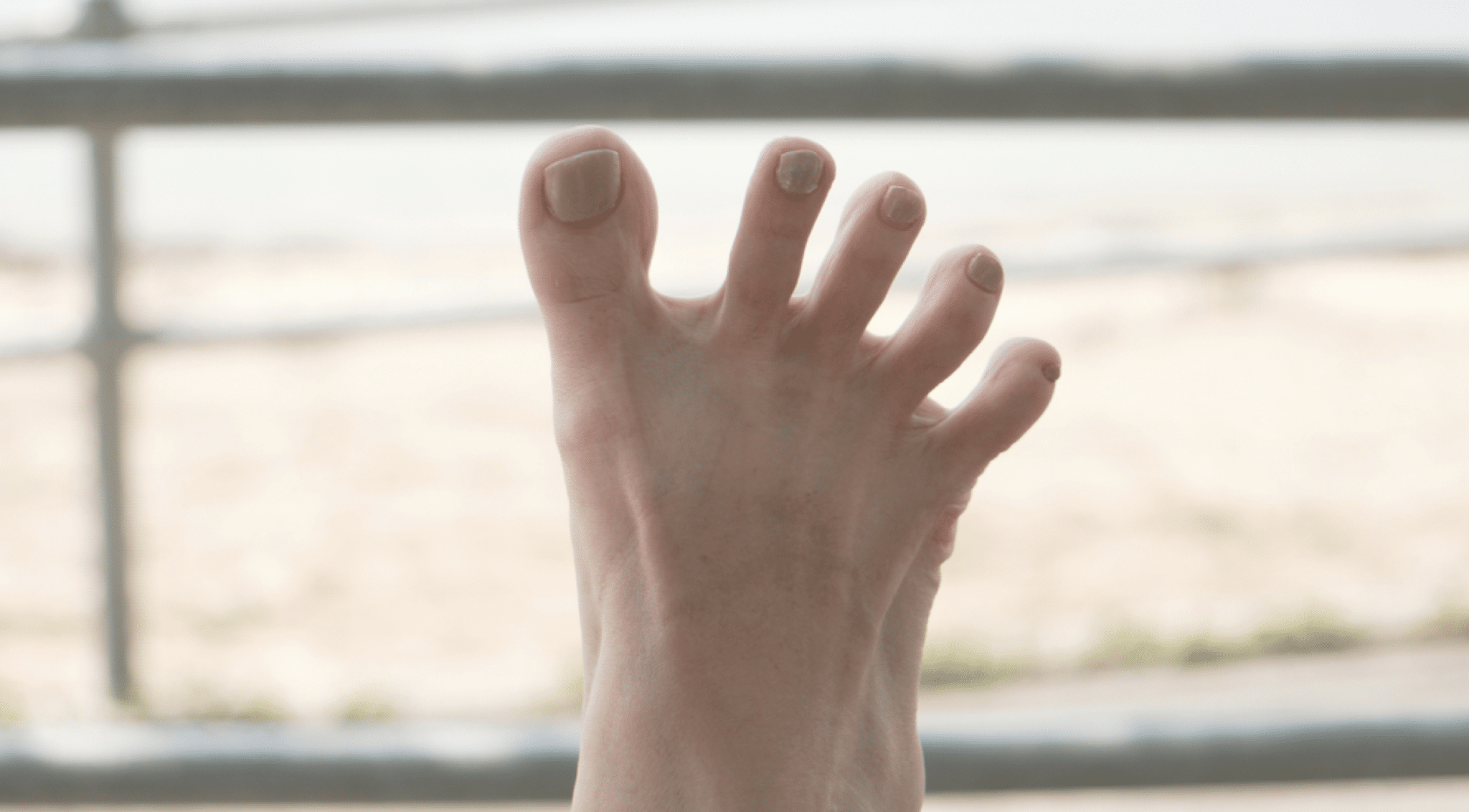
Corrective 5-finger socks for optimal posture support
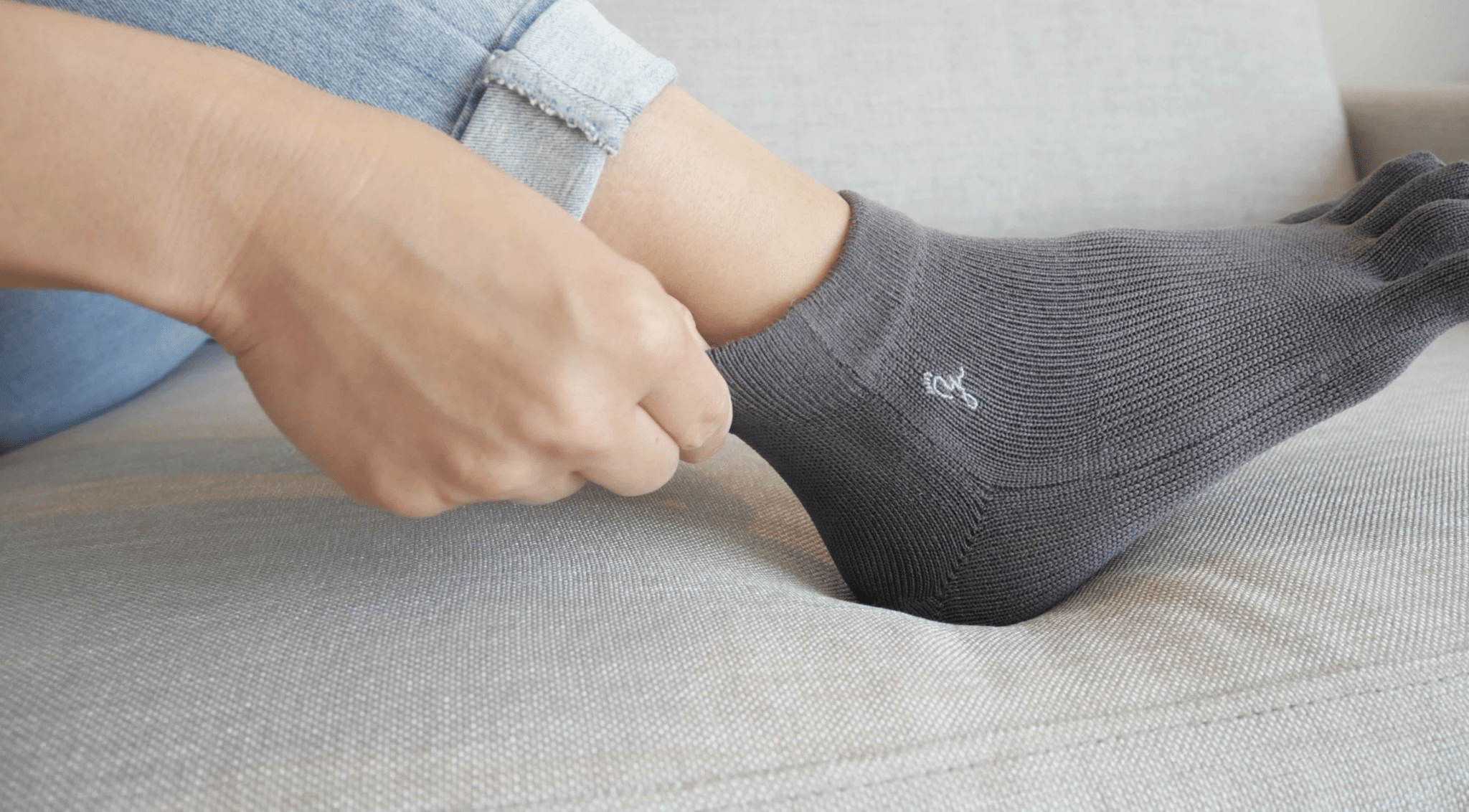
We have produced functional 5-finger socks made of cotton and silk and tried them on many patients in clinical settings, but we were unable to solve the problem of feet slipping in shoes and socks. Therefore, we spent two years working with a textile company to perfect the ideal fiber, and the corrective five-toed socks "YOSHIRO SOCKS" were born. If you suffer from frozen shoulder, please give them a try.
Moderate walking relieves frozen shoulder.
To make it more effective
By making small changes in daily life, such as toe stretching and wearing corrective five-toed socks (YOSHIRO SOCKS), you can maintain correct posture and improve inflammation of the muscles around the shoulder.
Walk with a small gait.
∙ Activities that involve the use of toes, such as walking up hills and stairs
. Avoid wearing footwear indoors.
Try to walk at least 6,000 steps a day.
Make sure the laces are tight.
...Avoid using ordered pillows and mats.
Choose the right shoes.
Use a shoehorn to put on your shoes.
Stretching the toes and walking with corrective five-toed socks (YOSHIRO SOCKS) helps to use the toes functionally.(1) Toe deformity improved → (2) Correct center of gravity position → (3) Improved posture → (4) Eliminated frozen shoulderThis is the flow of the project.
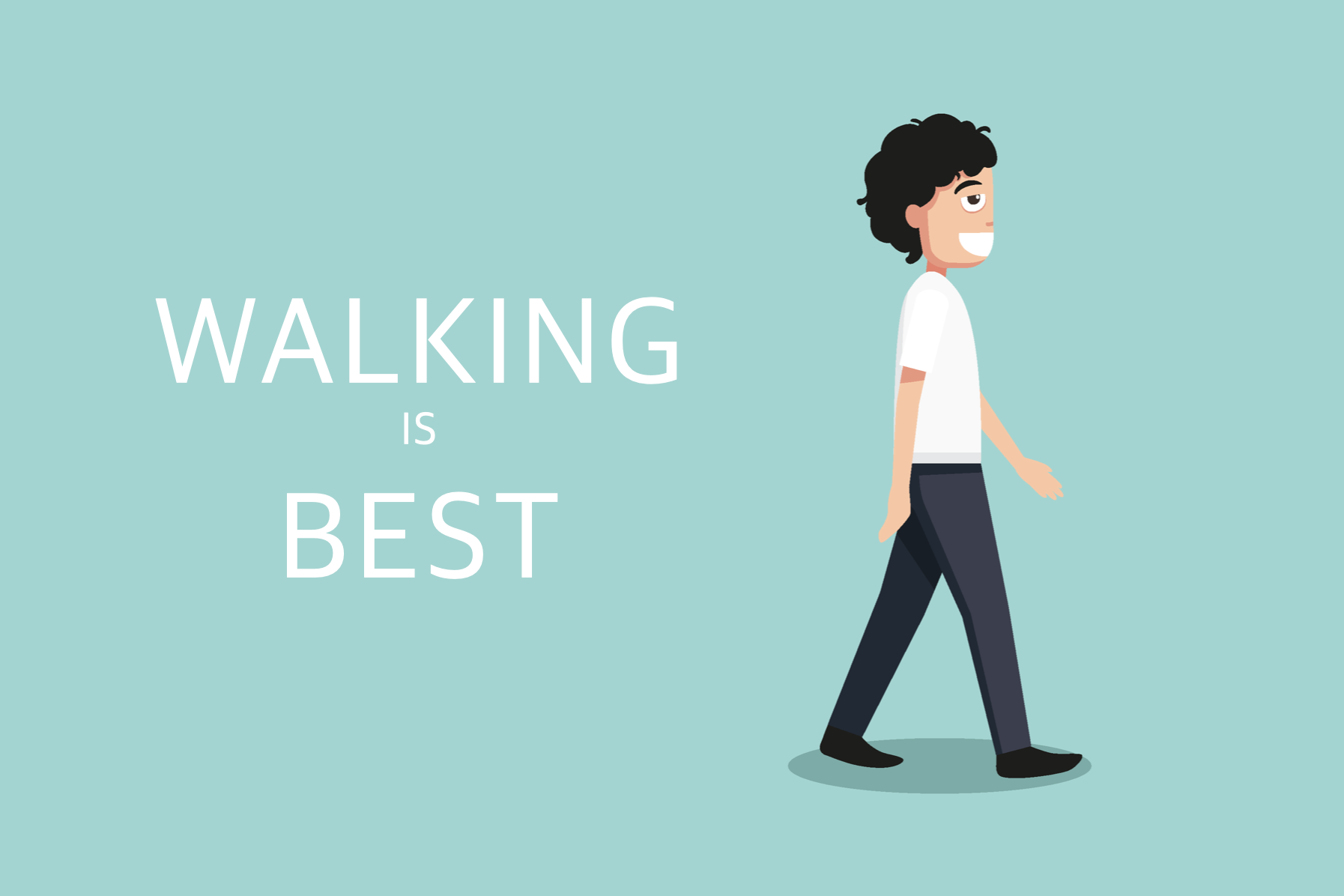
Correct posture is created by correct muscles.Correct muscles can only be built by walking with "toes spread and extended"!The goal is to walk at least 6,000 steps per day. Aim for 10,000 steps per day. You will notice that your blood circulation will improve and your stiff shoulders and neck will gradually disappear when you walk.
How to choose the right shoes
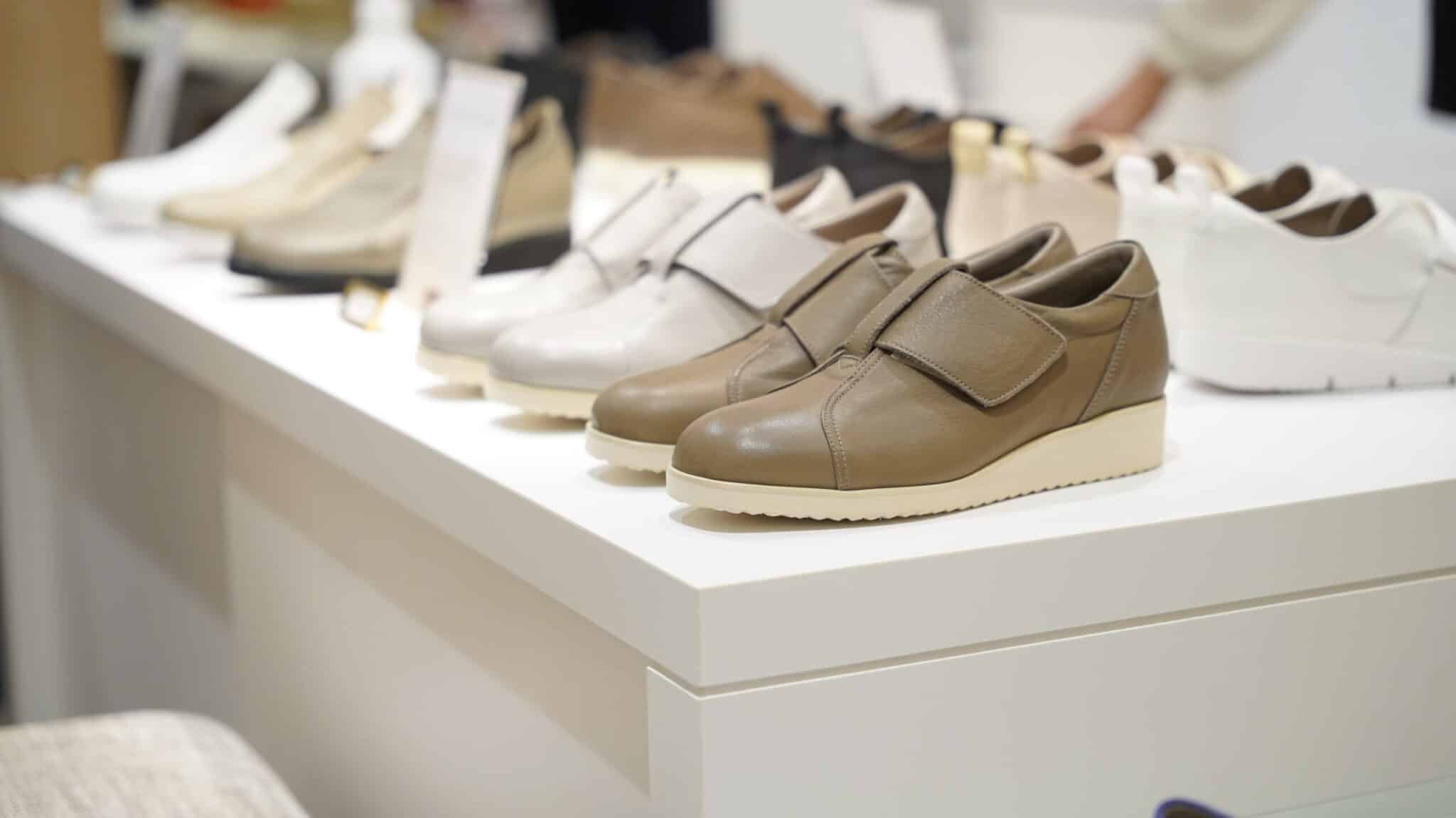
The most common cause of toe deformity is the choice of shoes and how they are worn.Many problems such as stiff shoulders and stiff necks are caused by not using the toes properly. Few people would think that because the feet and the head are located so far apart, they are not connected. If you are suffering from stiff shoulders and neck, please take this opportunity to review your feet.
How to choose the right socks
Pure cotton and silk materials are slippery
There is a silken finish (or mercerization process). Silkette treatment is a process that gives silk-like luster to yarns, and involves soaking yarns in a caustic soda (sodium hydroxide) solution and stretching them like hand-pulled udon noodles to straighten the cross section of the yarns. It is overwhelmingly used mainly for cotton and silk fibers (cotton).
The cross-section of the cotton is aligned, coloration is improved, and fluff is suppressed when processed, giving it a luxurious appearance. It is smooth and slippery to wear, but as the words "smooth" and "slippery" suggest, it is easy for the feet to slip inside shoes and socks. In other words, it is a material that can easily cause deformation of the toes.
Of course, there are cotton and silk materials that are not silken, so choosing such materials is also an important factor in preventing knee pain.
Five-toed socks allow toes to function.
Common socks are also called tube socks, and most people around the world have this type of socks. It is a shape that has been used for many years, but the tube type makes it difficult to use the toes properly. For this reason, socks with five separate toes are better, but there are many different types of this type.
The most important thing is to make sure it fits your own feet just right.The socks should be worn with a soft, comfortable, and comfortable footwear. If the fingertips or instep area is loose, even a good 5-finger sock will "slip". On the other hand, 5-finger socks that fit too tightly and feel oppressive are not recommended, as they can impede blood circulation. It is important to find 5-toed socks that feel "comfortable" when you try them on.
There are more and more socks with corrective power, but when I tried them, I found that many of them press down more strongly than I expected. Particularly in the area of the arch of the foot.Supporting the arch is important, but arch structure is a property that can lose its function if it is lifted too stronglySo, be sure to choose an arch that is also not too oppressive.
When you take it off, you say, "Ha, that feels good!" then the pressure is too strong.This is the case.
References
Functional Anatomy and Physical Therapy of Hallux Valgus. Yuasa, Keiro. Physical Therapy Vol.31 No.2 2014.2 P159-165
2. "Shift Your Toes and You'll Be Healthy" by Keiro Yuasa/author, PHP Kenkyujo, 2014.6
3. "Your back and hips will never get bent again in your life by grabbing your toes in just 5 minutes! Written by Keiro Yuasa, PHP Research Institute, 2021.6
4. McMahon PJ, et al. eds. Sports medicine: upper extremity. In: Current Diagnosis & Treatment in Orthopedics. 6th ed. McGraw Hill; 2021. https:// accessmedicine.mhmedical.com. Accessed June 18, 2022.
5.Frozen shoulder. American Academy of Orthopaedic Surgeons. https://orthoinfo.aaos.org/en/diseases-conditions/frozen- Frozen shoulder. Accessed June 14, 2022.
6.Prestgaard TA. Frozen shoulder (adhesive capsulitis). Accessed June 14, 2022. https://www.uptodate.com/contents/search. Accessed June 14, 2022.
7.Challoumas D, et al. Comparison of treatments for frozen shoulder: A systematic review and meta-analysis. JAMA Network Open. 2020; doi:10.1001/ jamanetworkopen.2020.29581.
8. Kim YJ. Acupuncture management for acute frozen shoulder: A case report. Clinical Case Reports. 2021; doi:10.1002/ccr3.5055.
